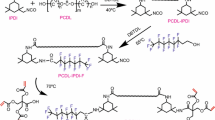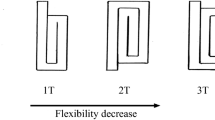Abstract
Two kinds of UV-curable polyurethane acrylates (PCDL-H-PUA and PCDL-P-PUA) were synthesized starting with polycarbonate diols (PCDL), isophorone diisocyanate and dimethylolpropionic acid and terminated with hydroxyethyl methacrylate or pentaerythritol triacrylate to impart mono-methacrylate or tri-acrylate end-group functionality, respectively. The structures and properties of the products were characterized by Fourier transform infrared spectroscopy, proton nuclear magnetic resonance spectroscopy, gel permeation chromatography and thermogravimetric analysis. The average molecular weights were between 7500 and 9300 g/mol, and the thermal properties of the products were excellent. The influence of the functionality of the end-capping functional group on the UV-curing behavior was investigated using real-time spectroscopy. Results showed that curing rate and conversion of PCDL-P-PUA were higher than those of PCDL-H-PUA, and the final double bond conversion of the polymers reached 95 %. PCDL-H-PUA and PCDL-P-PUA were applied to negative photoresists as the main film resin. The resolution of the optimal photoresist reached 40 µm.






Similar content being viewed by others
References
Guan J, Song Y, Lin Y et al (2011) Progress in study of non-isocyanate polyurethane. Ind Eng Chem Res 50(11):6517–6527
Liu N, Zhao Y, Kang M et al (2015) The effects of the molecular weight and structure of polycarbonatediols on the properties of waterborne polyurethanes. Prog Org Coat 82:46–56
Nam KH, Seo K, Seo J et al (2015) Ultraviolet-curable polyurethane acrylate nanocomposite coatings based on surface-modified calcium carbonate. Prog Org Coat 85:22–30
Nohra B, Candy L, Blanco JF et al (2015) From petrochemical polyurethanes to biobased polyhydroxyurethanes. Macromolecules 46:3771–3792
Lucio B, de la Fuente JL (2014) Rheological cure characterization of an advanced functional polyurethane. Thermochim Acta 596:6–13
Li K, Shen Y, Fei G et al (2015) Preparation and properties of castor oil/pentaerythritol triacrylate-based UV curable waterborne polyurethane acrylate. Prog Org Coat 78:146–154
Alishiri M, Shojaei A, Abdekhodaie MJ, Yeganeh H (2014) Synthesis and characterization of biodegradable acrylated polyurethane based on poly(ε-caprolactone) and 1,6-hexamethylene diisocyanate. Mater Sci Eng C 42:763–773
Li J, Zheng W, Zeng W, Zhang D, Peng X (2014) Structure, properties and application of a novel low-glossed waterborne polyurethane. Appl Surf Sci 307:255–262
Murakami H, Baba R, Fukushima M, Nonaka N (2015) Synthesis and characterization of polyurethanes crosslinked by polyrotaxanes consisting of half-methylated cyclodextrins and PEGs with different chain lengths. Polymer 56:368–374
Kojio K, Nakamura S, Furukawa M (2008) Effect of side groups of polymer glycol on microphase-separated structure and mechanical properties of polyurethane elastomers. J Polym Sci Part B Polym Phys 46:2054–2063
Hwang HD, Park CH, Moon JI et al (2011) UV-curing behavior and physical properties of waterborne UV-curable polycarbonate-based polyurethane dispersion. Prog Org Coat 72:663–675
Krol P, Krol B, Pielichowska K, Pikus S (2011) Comparison of phase structures and surface free energy values for the coatings synthesised from linear polyurethanes and from waterborne polyurethane cationomers. Colloid Polym Sci 289:1757–1767
Cakic SM, Stamenkovic JV, Djordjevic DM, Ristic IS (2009) Synthesis and degradation profile of cast films of PPG–DMPA–IPDI aqueous polyurethane dispersions based on selective catalysts. Polym Degrad Stab 94:2015–2022
Jiang X, Li J, Ding M et al (2007) Synthesis and degradation of nontoxic biodegradable waterborne polyurethanes elastomer with poly(ξ-caprolactone) and poly(ethylene glycol) as soft segment. Eur Polym J 43:1838–1846
Lee DK, Tsai HB, Tsai RS (2006) Aqueous polyurethane dispersions derived from polycarbonatediols and di (4-isocyanatocyclohexyl)methane. Polym Eng Sci 46(5):588–593
Durrieu V, Gandini A (2005) Preparation of aqueous anionic poly(urethane-urea) dispersions. Influence of the incorporation of acrylic, polycarbonate and perfluoro-oligoether diols on the dispersion and polymer properties. Polym Adv Technol 16:840–845
Lee DK, Tsai HB, Tsai RS (2006) Effect of composition on aqueous polyurethane dispersions derived from polycarbonatediols. J Appl Polym Sci 102(5):4419–4424
Chang S, Yang JH, Chien JH, Lee YD (2013) Synthesis of a novel alkaline-developable photosensitive copolymer based on MMA, MAA, SM, and 2-HEMA-grafted GMA copolymer for an innovative photo-imageable dry-peelable temporary protective plastisol. J Polym Res 20(4):1–11
Liu J, Zheng X, Li H et al (2015) Synthesis of novel branched UV-curable methacrylate copolymer and its application in negative photoresist. Polym Bull 72:523–533
Simone DD, Goethals AM, Roey FV et al (2014) Progresses and challenges of EUV lithography materials. J Photopolym Sci Technol 27(5):601–610
Li H, Liu J, Lin L et al (2014) Preparation and characterization of UV curable copolymers containing alkali soluble carboxyl pendant for negative photoresist. Polym Sci Ser B 56(6):855–862
Liu J, Lin L, Jia X et al (2014) Synthesis and properties of UV-curable hyperbranched polyurethane and its application in the negative-type photoresist. J Wuhan Univ Technol Mater Sci Edn 1:208–212
Acknowledgments
We acknowledge financial support from the National Nature Science Foundation of Jiangsu Province (No. BK20140160), the National Science and Technology Major Project of China (No. 2010ZX02304) and the Youth Fund Independent Research Plan of Jiangnan University (No. JUSRP11514).
Author information
Authors and Affiliations
Corresponding author
Rights and permissions
About this article
Cite this article
Liu, J., Liu, Q., Zheng, X. et al. Synthesis of UV-curable polycarbonate diols (PCDL)-based polyurethane acrylate for negative photoresist. Polym. Bull. 73, 647–659 (2016). https://doi.org/10.1007/s00289-015-1511-4
Received:
Revised:
Accepted:
Published:
Issue Date:
DOI: https://doi.org/10.1007/s00289-015-1511-4




